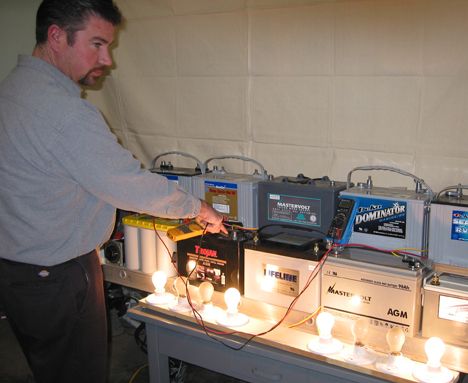[Updated December 5, 2018]
Few things are more disappointing than coming back to your boat in the spring and discovering that one or more of your boats batteries is dead. You haven’t even started sailing, and already you’re facing a hefty bill. Many times, a dead battery can be resuscitated to near its initial capacity, but it’s best to avoid the problem in the first place.
If you put your boat to bed recently and haven’t yet checked your batteries state of charge, now is a good time to do it. Ideally, you should bring a stored battery up to full charge at least once a month-this is not always possible, and may not be necessary so long as you start off with a full charge. If you keep your batteries fully charged, you shouldn’t have to worry about electrolyte freezing, and you’ll reduce the risk of diminishing the battery’s capacity. A fully charged, lead-acid battery will withstand temperatures of 75 degrees below zero without freezing. However, electrolyte in a fully discharged battery can start freezing at 32 degrees, just like water. Once the electrolyte freezes, you can pretty much kiss your battery goodbye.
If you havent put much thought into protecting your battery for the winter yet, don’t delay any longer. If the batteries are removed from the boat, store them in a cool place that does not drop too far below freezing. A basement or garage is fine. Todays batteries can be safely stored on a concrete floor without risk of discharge, but its a good idea to insulate them on a block of wood anyway-if only for peace of mind. You can keep house batteries on the boat, but if you do, you should take the usual boat winterizing steps– cleaning the battery top and battery posts, filling the electrolyte, eliminating any loads that may discharge the battery – and checking voltage and recharging on a monthly basis.
There are a few ways to check battery state. The more common methods of checking battery state are using a digital or expanded-scale voltage meter to check open-circuit voltage or, on wet-cell batteries, using a hydrometer to check the electolyte’s specific gravity. In either case, you need to make sure the batterys electrolyte is stabilized, otherwise you may get misleading results. By letting a battery rest for an hour or two after recharging-or after being subjected to discharge loads-the electrolyte is usually fairly stable. Typically, the electrolyte will be stabilized after only a few hours (or even minutes) of rest, but in some cases it may take up to 24 hours, even longer in some gel batteries.
If you have serious concerns about your batterys condition, you should consider having it load-tested at a reliable battery service center. Big boatyards, most automotive repair shops, and battery dealers will have a heavy-duty load tester suitable for high-capacity marine 12-volt batteries. Owners of inboard diesel engines can simulate a load test, a process that is described in Nigel Calders “Boatowners Mechanical and Electrical Manual.” Calder also describes how to compensate for temperature when checking for battery state and offers a few options for reviving bad batteries back to near capacity, tricks that can save you hundreds of dollars that you might have spent on a new battery you didnt need.
For more details on battery storage this winter, check out our online article on battery care, and 12 tips on extending AGM battery life. Owners of AGM batteries will be especially interested in our in-depth look at how repeated incomplete charge cycles can reduce the battery’s capacity. If you do find yourself shopping for a battery this winter, two other articles worth looking at are our test of sealed batteries and Andy OGradys article on extending the life of wet cell batteries like the popular Trojan 6-volts. Finally, if you are in the market for a new inverter charger or battery monitor, PSreviewed the best of the bunch.
If you really want to get into the nitty gritty of battery selection and system design, check out our e-book series on electrical systems, which has a section dedicated to 12-volt batteries and battery accessories.
[Editor’s note: 1/18/18: This post has been edited to clarify that leaving the battery on the boat is perfectly acceptable and common practice.]








































Hi ACOSolar team,
I am reaching out to you regarding an introduction to Braille Battery and discuss a potential partnership.
15 + years in Operation – We are lighter, stronger and most efficient battery on the market, best part is that we manufacture right in the USA – Sarasota to be exact!
I have attached some documents for your review which include our proven track record, Group 34 Flyer, Braille Lithium Benefits as well a comparison graph regarding lithium vs lead.
Race proven technology, supplying to more OEM’s & series globally than any other lithium battery. Applications include street/track/race/vehicles, military, commercial & industrial, marine and more.
Less than 1% failure, modern green technology, ultra-light weight and 10x’s life cycle.
Walk, crawl and run approach is how we do business to ensure a win win successful relationship for all.
Would you or parts distribution have any time this week for a call to discuss a possible partnership?
Wonderful review article! feeling lucky that I have found this site. very informative. can please tell me that which Boat Battery is the best for the Survive Winter?
Thanks for sharing such an informative article.
Hopefully, waiting for your more article in the future
Great article! Check that the engine is in good working order, as well as the battery. It will surely make my boating experience worthwhile. 🙂